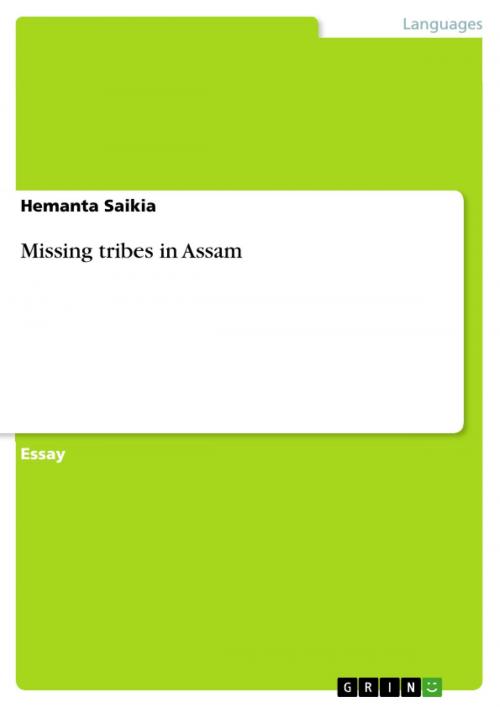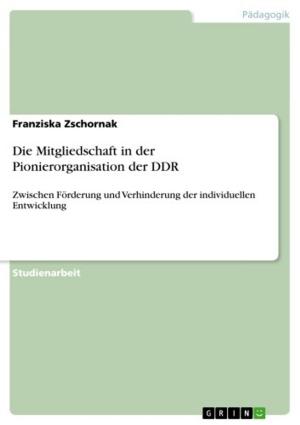Missing tribes in Assam
Nonfiction, Social & Cultural Studies, Social Science, Cultural Studies, Ethnic Studies| Author: | Hemanta Saikia | ISBN: | 9783656868804 |
| Publisher: | GRIN Verlag | Publication: | December 30, 2014 |
| Imprint: | GRIN Verlag | Language: | English |
| Author: | Hemanta Saikia |
| ISBN: | 9783656868804 |
| Publisher: | GRIN Verlag |
| Publication: | December 30, 2014 |
| Imprint: | GRIN Verlag |
| Language: | English |
Essay from the year 2013 in the subject South Asian Studies, South-Eastern Asian Studies, grade: A, , language: English, abstract: The Mising is a major ethnic group of north east India and second largest tribe in Assam. As per 2001 census the Mising constitutes 17.8 percent of the tribal population of Assam and the total numbers of Mising population is 587,310. They are found mostly in Lakhimpur, Jorhat, Dibrugarh Dhemaji and Golaghat Districts of Assam. The Mising, being riverside people, have special liking to live on the riverbanks in spite of the fact that they have to face the flood of the river during the monsoon. Sometime flood force them to shift their villages. The Mising are still very backward and their socio-economic conditions have not developed. This essay attempts to explore the socio-economic condition of Mising people of Assam. Despite of the development of the socio economic structure of the Missing tribes, there is a gap still remains the socio economic development. Even though constitution provided a strong framework for the development of the Mising tribes they are still remain backward and so still strong foundation for the development of them is needed.
Hemanta Saikia (M.A. & MARD, M. Phil, MBA, Ph.D) is working as Assistant Professor in the Department of Economics, Debraj Roy College, Golaghat, Assam. He has obtained dual master degree in Economics & Rural Development and also completed EMBA from IIBM India with specialization in International Business and Marketing Management, 2011. Hemanta Saikia also qualified UGC National Eligibility Test (NET) in Economics in the year 2008 with Junior Research Fellowship (JRF). After master degree he has successfully awarded M.Phil and Ph. D degree by Dibrugarh University in the year 2012. Over the years he has published and presented over 50 papers in national and international journals, seminars, workshop and conferences etc. Currently, he has five years of teaching experiences.
Essay from the year 2013 in the subject South Asian Studies, South-Eastern Asian Studies, grade: A, , language: English, abstract: The Mising is a major ethnic group of north east India and second largest tribe in Assam. As per 2001 census the Mising constitutes 17.8 percent of the tribal population of Assam and the total numbers of Mising population is 587,310. They are found mostly in Lakhimpur, Jorhat, Dibrugarh Dhemaji and Golaghat Districts of Assam. The Mising, being riverside people, have special liking to live on the riverbanks in spite of the fact that they have to face the flood of the river during the monsoon. Sometime flood force them to shift their villages. The Mising are still very backward and their socio-economic conditions have not developed. This essay attempts to explore the socio-economic condition of Mising people of Assam. Despite of the development of the socio economic structure of the Missing tribes, there is a gap still remains the socio economic development. Even though constitution provided a strong framework for the development of the Mising tribes they are still remain backward and so still strong foundation for the development of them is needed.
Hemanta Saikia (M.A. & MARD, M. Phil, MBA, Ph.D) is working as Assistant Professor in the Department of Economics, Debraj Roy College, Golaghat, Assam. He has obtained dual master degree in Economics & Rural Development and also completed EMBA from IIBM India with specialization in International Business and Marketing Management, 2011. Hemanta Saikia also qualified UGC National Eligibility Test (NET) in Economics in the year 2008 with Junior Research Fellowship (JRF). After master degree he has successfully awarded M.Phil and Ph. D degree by Dibrugarh University in the year 2012. Over the years he has published and presented over 50 papers in national and international journals, seminars, workshop and conferences etc. Currently, he has five years of teaching experiences.















